
Podocarpus latifolius is a large evergreen tree up to 35 m high and 3 m trunk diameter, in the conifer family Podocarpaceae; it is the type species of the genus Podocarpus.

Combretum imberbe is a characteristic and often impressive bushwillow species of the southern Afrotropics. The medium to large tree has a sparse, semi-deciduous canopy of grey-green leaves. The twigs and leaves are hairless as the name imberbe suggests. Its heartwood is dark brown, close-grained, and very hard and heavy, as suggested by its vernacular name. The durable heartwood is much sought after in the woodcarving industry. The Hereros and Ovambos of Namibia attach special cultural and religious significance to the tree, as to them it is the great ancestor of all animals and people, which must be passed with respect.
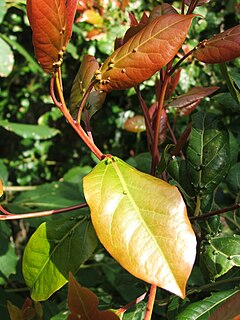
Ocotea bullata, is a species of flowering tree native to South Africa. It produces very fine and valuable timber which was formerly much sought after to make furniture. Due to over-exploitation it is now a protected species. Other names for it are Cape Walnut, Cape laurel, and laurel wood. The name "stinkwood" comes from a strong smell that is released when it is fresh felled.
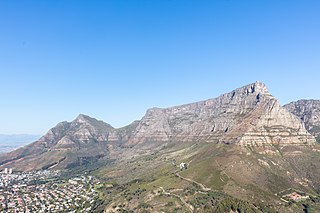
Table Mountain National Park, previously known as the Cape Peninsula National Park, is a national park in Cape Town, South Africa, proclaimed on 29 May 1998, for the purpose of protecting the natural environment of the Table Mountain Chain, and in particular the rare fynbos vegetation. The park is managed by South African National Parks. The property is included as part of the UNESCO Cape Floral Region World Heritage Site.

Leucadendron argenteum is an endangered plant species in the family Proteaceae, which is endemic to a small area of the Cape Peninsula, South Africa. Most grow in and around the city of Cape Town, but outlying populations exist near Somerset West (Silwerboomkloof), Paarl and Stellenbosch. It is a protected tree in South Africa.
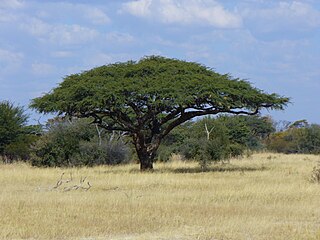
Vachellia erioloba, the camel thorn, giraffe thorn, or Kameeldoring in Afrikaans, still more commonly known as Acacia erioloba, is a tree of southern Africa in the family Fabaceae. Its preferred habitat is the deep dry sandy soils in parts of South Africa, Botswana, the western areas of Zimbabwe and Namibia. It is also native to Angola, south-west Mozambique, Zambia and Swaziland. The tree was first described by Ernst Heinrich Friedrich Meyer and Johann Franz Drège in 1836. The camel thorn is a protected tree in South Africa.

Adansonia digitata, the African baobab, is the most widespread tree species of the genus Adansonia, the baobabs, and is native to the African continent. The long-lived pachycauls are typically found in dry, hot savannas of sub-Saharan Africa, where they dominate the landscape, and reveal the presence of a watercourse from afar. Their growth rate is determined by ground water or rainfall, and their maximum age, which is subject to much conjecture, seems to be in the order of 1,500 years. They have traditionally been valued as sources of food, water, health remedies or places of shelter and are steeped in legend and superstition. European explorers of old were inclined to carve their names on baobabs, and many are defaced by modern graffiti.

The wildlife of Burundi is composed of its flora and fauna. The small, landlocked country is home to 2,950 species of plants, 596 birds, 163 species of vertebrates, 52 species of reptiles, 56 species of amphibians, and 215 fish species. The wildlife has been drastically reduced in recent years, mainly on account of intense population pressure, conversion of large areas of forest into agricultural land, and extensive livestock farming. The protected area encompasses little more than 5% of the total area of the country.

Podocarpus elongatus, the Breede River yellowwood, is a species of conifer in the family Podocarpaceae. In contrast to other yellowwood species of southern Africa, Podocarpus elongatus often resembles an enormous, round, multi-stemmed bush in its habit. The Breede River yellowwood is a protected tree in South Africa.

Podocarpus henkelii is a South African species of conifer in the family Podocarpaceae. It is grown ornamentally in gardens for its strikingly neat, attractive form and its elegant, drooping foliage.

Widdringtonia wallichii, Clanwilliam cedar or Clanwilliam cypress, previously Widdringtonia cedarbergensis is a species of Widdringtonia native to South Africa, where it is endemic to the Cederberg Mountains northeast of Cape Town in Western Cape Province. It is threatened by habitat loss and protected in South Africa under the National Forest Act of 1998.
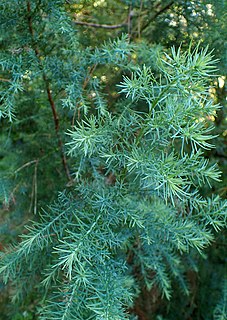
Widdringtonia schwarzii is a species of Widdringtonia native to South Africa, where it is endemic to the Baviaanskloof and Kouga Mountains west of Port Elizabeth in Eastern Cape Province; it occurs on dry rocky slopes and crags at 600-1,200 m altitude. It is threatened by habitat loss, particularly by wildfire. The Willowmore cypress is a protected tree in South Africa.

Protea comptonii, also known as saddleback sugarbush, is a smallish tree of the genus Protea in the family Proteaceae. It is found in South Africa and Eswatini.

Protea curvata is a species of plant in the family Proteaceae. It is endemic to South Africa, and a protected tree there.

The Kanku-Breakaways Conservation Park is a protected area in northern South Australia, just off the Stuart Highway 33 km (21 mi) north of Coober Pedy. The Breakaways CP is managed under a co-management agreement by the Department of Environment, Water, and Natural Resources in conjunction with the Antakirinja Matu-Yankunytjatjara Aboriginal Corporation and the District Council of Coober Pedy.

Rhizophora mucronata is a species of mangrove found on coasts and river banks in East Africa and the Indo-Pacific region.

Ceriops tagal, commonly known as spurred mangrove or Indian mangrove, is a mangrove tree species in the family Rhizophoraceae. It is a protected tree in South Africa. The specific epithet tagal is a plant name from the Tagalog language.
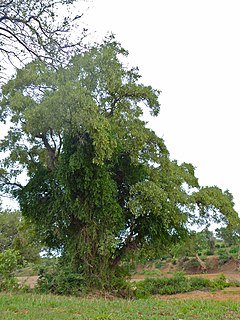
Philenoptera violacea known also as apple leaf or rain tree, Afrikaans: Appelblaar, Sotho: Mphata, Tsonga: Mohata, Zulu: Isihomohomo) is a plant species in the legume family (Fabaceae).

Vachellia haematoxylon is a protected tree in South Africa.

Euclea pseudebenus is a tree native to Angola, Namibia and the Cape Province region of South Africa. It is classified as a protected tree in South Africa.



















